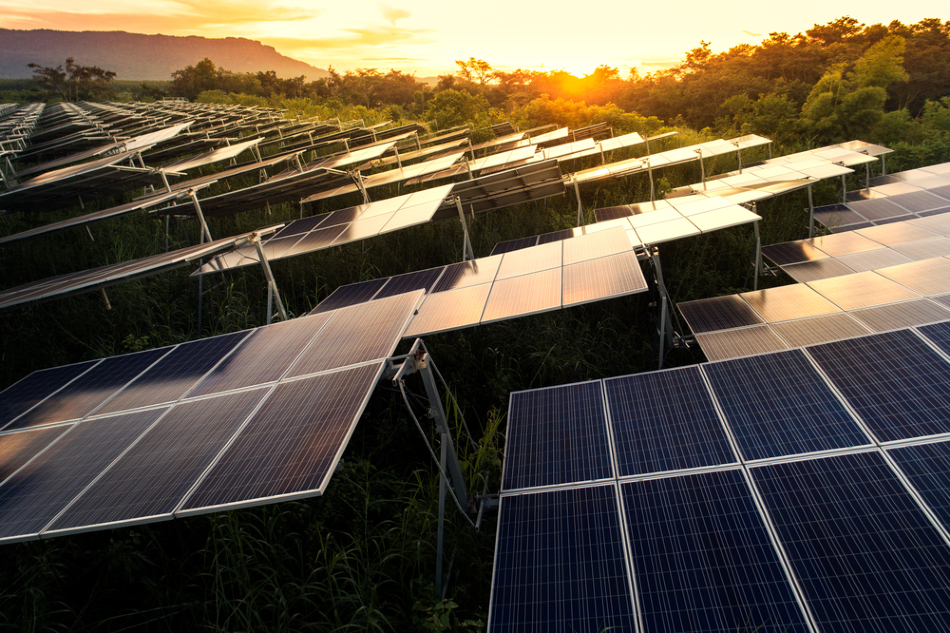Dr. Adrian (Lei) Shi speaks to AZoM about a groundbreaking perovskite solar cell that could revolutionize the industry and open up new applications.
How did you begin your research into perovskite solar cells?
I changed my research topic to perovskite solar cells halfway through my Ph.D. because I wanted to make a more tangible difference to the research of next-generation solar cells. Perovskite solar cells were a rising star at that time and our school just established a perovskite research team. They needed someone to look into the encapsulation technique for protecting the perovskite cells from moisture. After two years of research, I started to realize encapsulation can be used in a very unconventional and interesting way for perovskite.
What is perovskite and what properties make it so revolutionary?
Perovskite refers to a material with a very specific arrangement of atoms. It has an ABX3 chemical formula. For typical high-efficient solar cell material, A is an organic cation (positive molecule), B is metal (typically lead), and X is halogen anion (negative molecule).
It is one of only three materials from which solar cells of over 25% energy conversion efficiency have been made. It is the simplest and probably cheapest to prepare because it is much more tolerant of defects.
In comparison, solar cell-grade silicon has a defect concentration level of ppb (parts per billion), while perovskite can tolerate defects in percentage level.
What are the main differences between perovskite solar cells and traditional silicon ones?
Silicon has a low defect tolerance, making it expensive to produce. The high-temperature (i.e., high energy cost) process is essential to ensure its purity.
Perovskite solar cells are generally fabricated at a temperature of below 150 °C and have the potential to beat the minimum cost of silicon cells. It is a thin-film solar cell, which means it only needs hundreds of nanometer-thick perovskite to absorb as much sunlight as silicon, which is typically 150-200 micrometers thick.
Silicon cells can be made in thin-films too, but the high defect level makes the efficiency very low (~10%). Low weight and flexible perovskite thin-film solar cells have more applications than conventional silicon wafer cells, such as for aircraft and spacecraft. The low weight also helps lower the shipping and installation costs.
Although silicon cells are chemically stable, perovskite has a unique, organic/inorganic hybrid structure, which grants it many merits. However, this also renders it very unstable, which is a major obstacle for the commercialization of perovskite solar cells.
Perovskite crystals degrade much faster than silicon. Why is this so problematic in terms of commercial solar cells?
Perovskite’s unique material structure makes it vulnerable to environmental stresses such as moisture, heat and light – all that an outdoor solar cell has to endure in its life. The root problem is the weak bonding among different molecules that comprise perovskite (organic molecule, metal atom and halogen atoms). The material can be debonded by the environmental stresses, leading to the decomposition of the perovskite material.
Commercial silicon solar panels have a guaranteed lifetime of 25 years, whereas perovskite cells only currently last a few months or years.
Though the fabrication cost of perovskite solar cells can be lower than Si, if the electricity that can be generated throughout the lifetime of a solar panel (which is also called LCOE) is considered, perovskite cells are not competitive to Si cells, as a perovskite cell's lifetime is much shorter. Scientists are working to match the lifetime of silicon solar cells, and our work shows it is achievable.
What tests do solar cells need to pass to be considered suitable for commercial use?
All outdoor solar panels need to pass a few standard tests before they can be commercial. IEC61215:2016, developed by International Electrotechnical Commission in 2016, is one of the most widely adopted standards. It covers a wide range of tests, including power rating, electrical safety, mechanical durability, illumination durability, moisture durability, and temperature durability.
If perovskite solar cells are to be commercially available, this kind of test cannot be avoided.
In our work, we made the perovskite solar cells stable enough to exceed the test requirement of IEC61215:2016 for moisture durability and temperature durability. Considering the special material stability problem, new additional tests could be designed for perovskite.

Image Credit: Thongsuk Atiwannakul/Shutterstock.com
In your research, what coating did you use to cover the perovskite and how did you do so?
Perovskite decomposes into gaseous products under environmental stress. Encapsulation can protect perovskite from external moisture and it can also prevent the escape of the decomposition gases. Once the pressure of these gases builds up inside the encapsulated cells, the decomposition reactions reach equilibrium and effectively stop, and, consequently, perovskite becomes stable.
We used polymer encapsulants stacking with glass to encapsulate the perovskite solar cells fully. We tried two types of polymer encapsulant, PVS 101 (polyisobutylene based sealant) and a polyolefin-based polymer (the exact name is confidential at the moment). We found that both work very well. These encapsulants are designed to withstand moisture ingress for silicon solar panels. In our work, they stopped the moisture ingress as well as the egress of the decomposition gases.
How did you use GC-MS to isolate and characterize the degradation of perovskite crystals?
Using encapsulation to stabilize perovskite solar cells is widely acknowledged, but past research has not proved that it works. We are the first to directly demonstrate that encapsulation stops decomposition by using GC-MS (gas chromatography and mass spectrometry), which is widely used in biochemistry and food science.
GC-MS can identify and quantify the gases with a high degree of unambiguity. We first sealed the perovskite samples in a vial and baked it at its highest working temperature for 100 hours. Then we used GC-MS to identify and quantify the gases inside the vial.
How was GC-MS used to show that the polymer/glass coating effectively protected the perovskite crystals?
After analyzing these gases, we were able to clarify the decomposition pathways of perovskite solar cell materials at different temperatures, without interference from the outgassing of polymer encapsulants.
By comparing the amount of the cell outgassing before and after encapsulation, with a cross-check by X-ray diffraction and efficiency measurement, we can tell whether encapsulation stops decomposition.
How could this breakthrough lower the costs of photovoltaics?
This breakthrough shows that perovskite solar cells can be as stable as silicon solar cells under high-moisture and high-temperature conditions. It marks a milestone reached in a journal towards 25-30 years perovskite solar cell lifetime, which is vital to its LCOE (levelized cost of electricity).
How long will the commercialization of this technology take and what stages need to be undertaken?
Stability is still the main obstacle to commercialization. In addition to that, other barriers are maintaining high efficiency using low-cost materials and processes as well as making solar cells uniformly in a large area.
In the laboratory, high-cost organic hole transportation material and gold metal are usually used, and the cell area is typically below tens of cm2.
There are already a few start-up companies manufacturing perovskite solar cells on a small scale. The companies aim to showcase their technology and fundraise.
Oxford PV plans to deliver commercially competitive perovskite-silicon tandem solar cells to high-end users in 2021. It seems the LCOE is still not low enough to compete with the full range of silicon solar cells, which is probably due to the relatively low lifetime.
If commercialization is achieved, how will this development revolutionize the solar cell industry?
The main advantage over silicon cells would be that, unlike silicon, the cells are very flexible, opening up new applications. However, the most promising application might be to combine perovskite with silicon to form a stacked tandem cell, where the perovskite cell converts the blue light and the silicon’s red light to produce up to 40% more energy generated from the same-sized solar panel.
How are you trying to develop solar cells for use in space and what sort of conditions must these cells be able to withstand?
In space, cells are exposed to damaging radiation that Earth usually protects them from with its magnetic field. Here, the ability of perovskites to tolerate defects caused by this radiation might prove important.
What is the next step for your research?
We are currently looking at the stability of perovskite cells at working conditions (under illumination with load). We are particularly interested in addressing the low stability of perovskite cells under combined heat/light stress. I believe solving this issue will make perovskite solar cells truly stable.
Where can readers find more information?
The details of the work can be found in the research article we recently published in the Science journal: https://science.sciencemag.org/content/368/6497/eaba2412. It includes a review of perovskite solar cell stability development in the Introduction section.
About Dr. Adrian (Lei) Shi
 Dr. Adrian (Lei) Shi is a post-doctoral researcher at the School of Photovoltaic and Renewable Energy Engineering of the University of New South Wales, Australia. He has a background in electronic engineering and obtained a Ph.D. degree in photovoltaic engineering. He has over 10 years’ experience in solar energy research and education.
Dr. Adrian (Lei) Shi is a post-doctoral researcher at the School of Photovoltaic and Renewable Energy Engineering of the University of New South Wales, Australia. He has a background in electronic engineering and obtained a Ph.D. degree in photovoltaic engineering. He has over 10 years’ experience in solar energy research and education.
Disclaimer: The views expressed here are those of the interviewee and do not necessarily represent the views of AZoM.com Limited (T/A) AZoNetwork, the owner and operator of this website. This disclaimer forms part of the Terms and Conditions of use of this website.